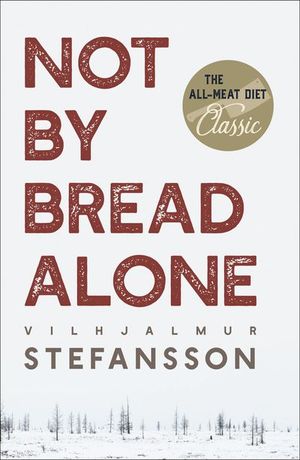Not by Bread Alone
Published by Echo Point Books
The arctic explorer’s classic text on the benefits of an all-meat diet chronicles his experiences and clinical studies of Inuit food habits.
Arctic explorer and anthropologist Vilhjalmur Stefansson spent years living with indigenous Inuit and Eskimo people. He noted their general healthiness (and good teeth), and an absence of many of the diseases that plagued western cultures, such as scurvy, heart disease, and diabetes. Observing their dietary habits, he determined that their primary food was meat, both lean and fatty, and that their diets were very low in sugary or starchy carbohydrates. Was this meaty diet the key to their good health?
Stefansson’s classic Not By Bread Alone chronicles a 1928 scientific experiment, conducted by the Russell Sage Institute of Pathology at Bellevue Hospital in New York, in which Stefansson and his colleague Dr. Karsten Andersen ate a meat-only diet for one year. The two men stayed healthy and fared very well, leading him to claim that we should reexamine our notion of what foods constitute a healthy diet.
Later chapters promote the benefits of pemmican, a compact, portable, and high-energy food consisting of a concentrated mix of fat and protein made from dried lean bison meat—sometimes mixed with berries—what you might call the original energy bar.
Arctic explorer and anthropologist Vilhjalmur Stefansson spent years living with indigenous Inuit and Eskimo people. He noted their general healthiness (and good teeth), and an absence of many of the diseases that plagued western cultures, such as scurvy, heart disease, and diabetes. Observing their dietary habits, he determined that their primary food was meat, both lean and fatty, and that their diets were very low in sugary or starchy carbohydrates. Was this meaty diet the key to their good health?
Stefansson’s classic Not By Bread Alone chronicles a 1928 scientific experiment, conducted by the Russell Sage Institute of Pathology at Bellevue Hospital in New York, in which Stefansson and his colleague Dr. Karsten Andersen ate a meat-only diet for one year. The two men stayed healthy and fared very well, leading him to claim that we should reexamine our notion of what foods constitute a healthy diet.
Later chapters promote the benefits of pemmican, a compact, portable, and high-energy food consisting of a concentrated mix of fat and protein made from dried lean bison meat—sometimes mixed with berries—what you might call the original energy bar.
BUY NOW FROM
COMMUNITY REVIEWS

